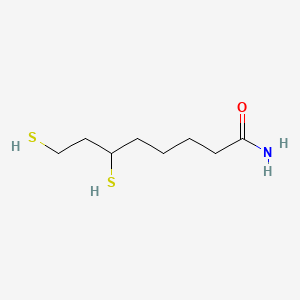| MeSH term | MeSH ID | Detail |
|---|---|---|
| Parkinsonian Disorders | D020734 | 20 associated lipids |
Dihydrolipoamide
Dihydrolipoamide is a lipid of Fatty Acyls (FA) class. Dihydrolipoamide is associated with abnormalities such as Wiskott-Aldrich Syndrome. The involved functions are known as Citric Acid Cycle, Electron Transport, NADH oxidation, Oxidation and Oxidants. Dihydrolipoamide often locates in Mitochondria, Mitochondrial matrix and Chloroplasts. The associated genes with Dihydrolipoamide are Mutant Proteins, Recombinant Proteins, mycothione reductase, Genes, Mitochondrial and alanylproline.
Cross Reference
Introduction
To understand associated biological information of Dihydrolipoamide, we collected biological information of abnormalities, associated pathways, cellular/molecular locations, biological functions, related genes/proteins, lipids and common seen animal/experimental models with organized paragraphs from literatures.
What diseases are associated with Dihydrolipoamide?
Dihydrolipoamide is suspected in and other diseases in descending order of the highest number of associated sentences.
Related references are mostly published in these journals:
| Disease | Cross reference | Weighted score | Related literature |
|---|
Possible diseases from mapped MeSH terms on references
We collected disease MeSH terms mapped to the references associated with Dihydrolipoamide
PubChem Associated disorders and diseases
What pathways are associated with Dihydrolipoamide
There are no associated biomedical information in the current reference collection.
PubChem Biomolecular Interactions and Pathways
Link to PubChem Biomolecular Interactions and PathwaysWhat cellular locations are associated with Dihydrolipoamide?
Visualization in cellular structure
Associated locations are in red color. Not associated locations are in black.
Related references are published most in these journals:
| Location | Cross reference | Weighted score | Related literatures |
|---|
What functions are associated with Dihydrolipoamide?
Related references are published most in these journals:
| Function | Cross reference | Weighted score | Related literatures |
|---|
What lipids are associated with Dihydrolipoamide?
There are no associated biomedical information in the current reference collection.
What genes are associated with Dihydrolipoamide?
Related references are published most in these journals:
| Gene | Cross reference | Weighted score | Related literatures |
|---|
What common seen animal models are associated with Dihydrolipoamide?
There are no associated biomedical information in the current reference collection.
NCBI Entrez Crosslinks
All references with Dihydrolipoamide
Download all related citations| Authors | Title | Published | Journal | PubMed Link |
|---|---|---|---|---|
| pmid:22100759 | ||||
| Schlüter A et al. | Functional genomic analysis unravels a metabolic-inflammatory interplay in adrenoleukodystrophy. | 2012 | Hum. Mol. Genet. | pmid:22095690 |
| Schmidt MC et al. | Efficient α, β-motif finder for identification of phenotype-related functional modules. | 2011 | BMC Bioinformatics | pmid:22078292 |
| Vazquez A et al. | Serine biosynthesis with one carbon catabolism and the glycine cleavage system represents a novel pathway for ATP generation. | 2011 | PLoS ONE | pmid:22073143 |
| Ninomiya M et al. | PBC: Animal Models of Cholangiopathies and Possible Endogenous Viral Infections. | 2012 | Int J Hepatol | pmid:22007316 |
| Stobbe MD et al. | Critical assessment of human metabolic pathway databases: a stepping stone for future integration. | 2011 | BMC Syst Biol | pmid:21999653 |
| Sasaki M and Nakanuma Y | Novel approach to bile duct damage in primary biliary cirrhosis: participation of cellular senescence and autophagy. | 2012 | Int J Hepatol | pmid:21994884 |
| Sandoval JM et al. | Glucose-6-phosphate dehydrogenase protects Escherichia coli from tellurite-mediated oxidative stress. | 2011 | PLoS ONE | pmid:21984934 |
| Skapski A et al. | Genome-scale analysis of Mycoplasma agalactiae loci involved in interaction with host cells. | 2011 | PLoS ONE | pmid:21966487 |
| Vaubel RA et al. | Mutations in the dimer interface of dihydrolipoamide dehydrogenase promote site-specific oxidative damages in yeast and human cells. | 2011 | J. Biol. Chem. | pmid:21930696 |
